




How to Solve Octal Number Problems Easily
The ‘Sum' of two integers is the place in the ‘sum' area where these two columns overlap,octal number addition follows the same rules as decimal or binary number addition. Octal addition is performed similarly to decimal addition.
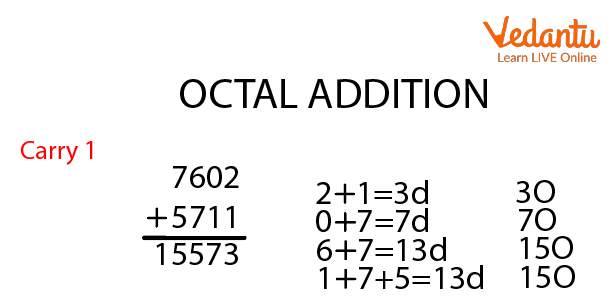
Octal Addition
How Does the Octal Number System Work?
The Octal Number System is a number system having an 8 as its base and digits ranging from 0 to 7. The term octal refers to numerals with an eight as their base. Octal numbers have numerous uses and are widely used in computers and digital numbering systems. Octal numbers can be converted to binary numbers, decimal numbers, and hexadecimal numbers in the number system.
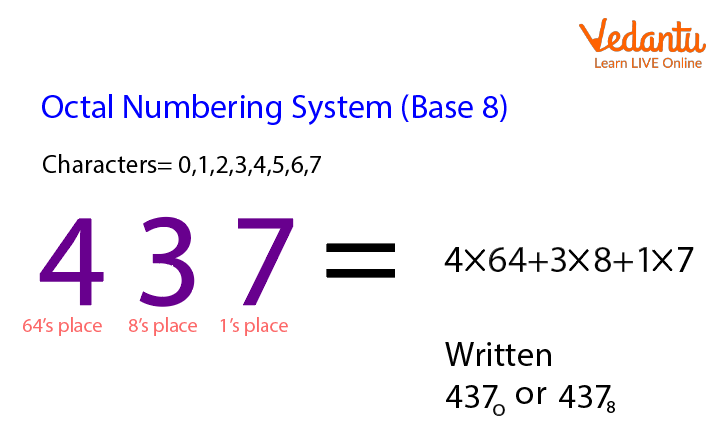
Numbering System
Octal Number Chart
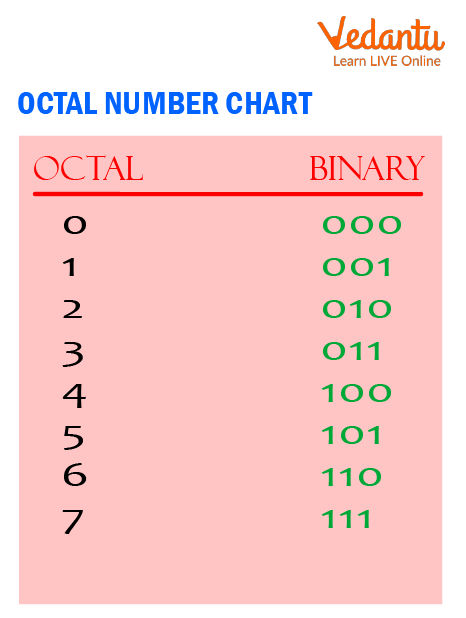
Octal Numbers Chart
Octal Addition Calculator
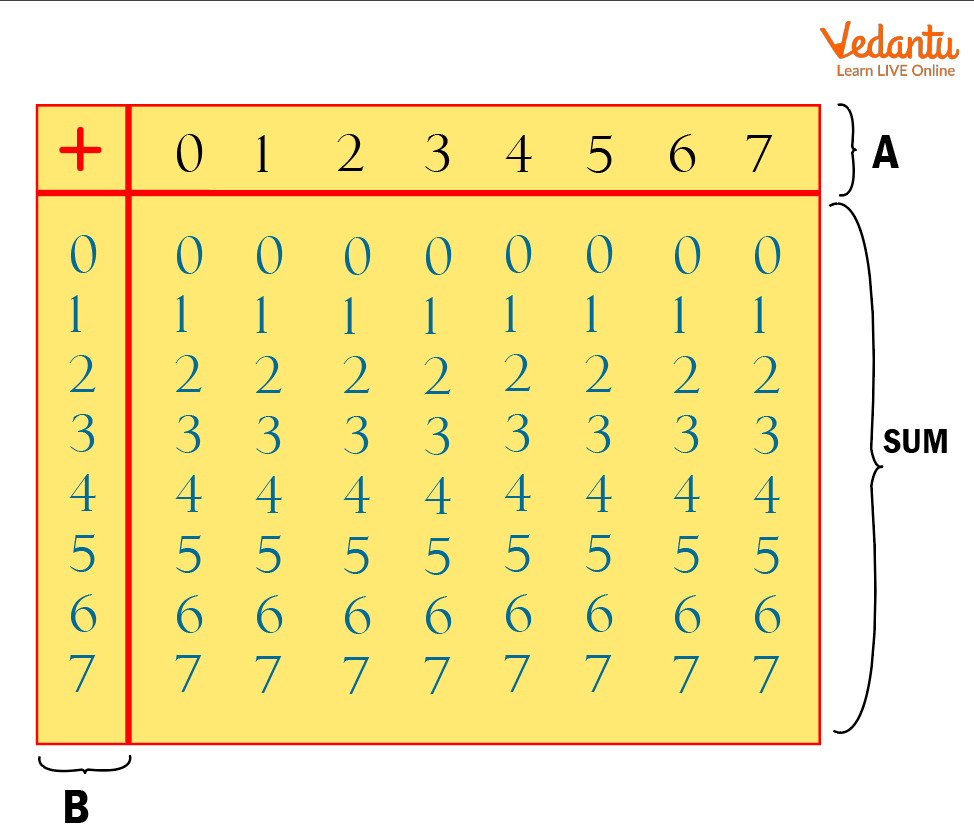
Octal Addition Table
68 + 58 = 138.
Simply follow the instructions in this example to use this table: Add 68 and 58 together. Locate 6 in the A column, then 5 in the B column. The ‘Sum' of two integers is the place in the ‘sum’ area where these two columns overlap.
How To Convert Octal To Decimal Form?
Octal to Decimal conversion is similar to other number system conversions such as decimal to octal, octal to hexadecimal, octal to binary, and so on. When converting from octal to decimal, an octal number with the base of 8 must be converted to a decimal number with the base of 10. When we wish to know the number system equivalent of a number, we convert it from octal to decimal. There are four sorts of number systems: binary number systems, octal number systems, decimal number systems, and hexadecimal number systems. Each number system has its own set of base numbers that aid in determining the type of number. These base numbers are also useful in converting octal to decimal. The base number for octal numbers is 8 and for decimal numbers it is 10.
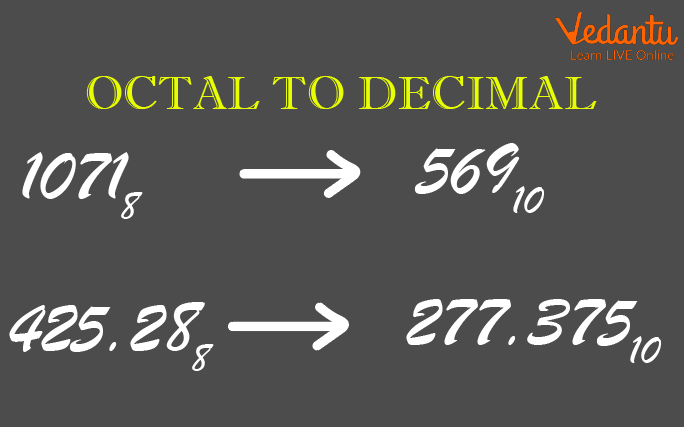
Octal to Decimal Conversion
Steps To Convert Octal To Decimal :
Here are the steps for converting an octal number to a decimal number:
Step 1: Because an octal number can only include digits ranging from 0 to 7, we must first arrange the octal number with the power of 8.
Step 2: We calculate the value of each octal number by evaluating all power of 8 values such as 80 is 1, 81 is 8, and so on.
Step 3: Once we have the value, we multiply each number.
Step 4: To acquire the decimal number, sum the product of all the numbers.
Example of Octal Addition
Consider the following example: convert (140) to 8 base, into a digit number
Step 1: Write 140 multiplied by the power of 8. Begin on the right-hand side.
1 × 82+ 4 × 81 + 0 × 80
Step 2: For each octal number, calculate the power of 8 values.
82 = 64, 81 = 8, 80 = 1
Step 3: Multiply each power of 8 by the corresponding number.
1 × 64 + 4 × 8 + 0 × 1 = 64 + 32 + 0
Step 4: Add the values together to get the decimal number.
64 + 32 + 0 = 96.
Therefore,( 140)= (96) to the base 10 .
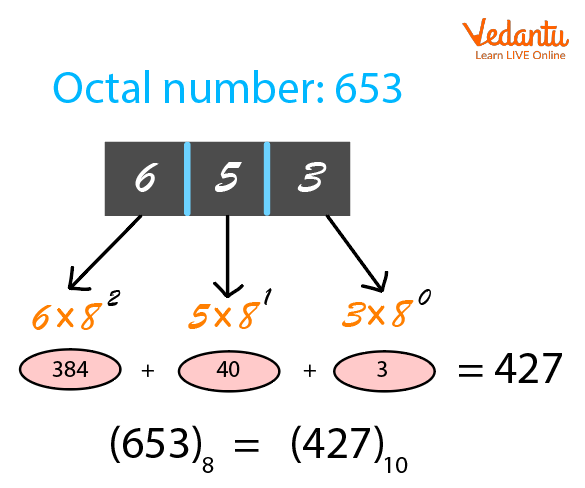
Octal to Decimal Conversion
Solved Questions
1. What is octal?
Ans: Employing a system of numerical notation with a base of 8 rather than 10 Choosing an octal number over a binary number saves digits. Octal was commonly employed in the early days of computers.
2. What is octal and binary?
Ans: Base 8 for octal numbers and base 2 for binary numerals We can translate the octal number to decimal, and then the decimal number to its binary equivalent.
3. What is the difference between octal, decimal and binary and hexadecimal?
Ans: In the number system, numbers are represented by their bases. Numbers have four bases: binary, octal, decimal, and hexadecimal. The base is binary if it is 2, octal if it is 8, decimal if it is 10, and hexadecimal if it is 16.
Summary
The main benefit of adopting Octal numbers is that they have fewer digits than the decimal and hexadecimal number systems. As a result, there are fewer computations and fewer computational errors. It just requires three bits to represent each digit in binary and is simple to convert from octal to binary and vice versa. However, octal numbers are no longer commonly used, and, as previously stated, the hexadecimal numbering system has taken their place. One disadvantage of the octal number system is that computers can not understand octal numbers directly, thus they must first be transformed to binary numbers.
FAQs on Addition and Subtraction of Octal Numbers
1. What is an octal number system and can you provide an example?
The octal number system is a base-8 system, which means it uses eight unique digits to represent any number: 0, 1, 2, 3, 4, 5, 6, and 7. In this system, each digit's position corresponds to a power of 8. For example, the octal number (27)₈ is equivalent to (2 * 8¹) + (7 * 8⁰), which equals 16 + 7, or 23 in the decimal system.
2. Why is the octal system also known as a 'base-8' number system?
The term 'base' in any number system refers to the total count of unique digits used. The octal system is called base-8 because it is constructed using exactly eight digits (0 through 7). Consequently, the value of each position in an octal number is determined by a corresponding power of 8, making it a foundational principle of the system.
3. What is the main difference between the octal and decimal number systems?
The primary difference between the octal and decimal systems lies in their base value. The decimal system is base-10 and uses ten digits (0-9), while the octal system is base-8 and uses only eight digits (0-7). This fundamental difference changes how numbers are structured:
- In the decimal system, positional values are powers of 10 (e.g., 1s, 10s, 100s).
- In the octal system, positional values are powers of 8 (e.g., 1s, 8s, 64s).
4. Where are octal numbers used in real-world computing?
Octal numbers are primarily used in computing because of their direct relationship with the binary system (as 2³ = 8). One of the most common modern examples is in file permissions on Unix-based operating systems like Linux and macOS. For instance, in the command `chmod 755`, each digit (7, 5, 5) is an octal representation of 3-bit binary permissions for the owner, group, and others.
5. How do you convert a decimal number to an octal number?
To convert a decimal number to octal, you use the repeated division-by-8 method. Here are the steps using decimal 90 as an example:
- Divide the decimal number by 8 and record the remainder. (90 ÷ 8 = 11, Remainder is 2)
- Divide the quotient from the previous step by 8. (11 ÷ 8 = 1, Remainder is 3)
- Repeat until the quotient is 0. (1 ÷ 8 = 0, Remainder is 1)
- The octal number is the sequence of remainders read from the bottom up.
Therefore, the decimal number 90 is equivalent to (132)₈ in octal.
6. What is the method for converting a binary number to its octal equivalent?
The conversion from binary to octal is straightforward due to their base relationship. The method is to group binary digits into sets of three.
- Starting from the right of the binary number, group the digits in sets of three.
- If the leftmost group has fewer than three digits, add leading zeros to complete the set.
- Convert each 3-bit binary group into its single-digit octal equivalent (e.g., 101 = 5, 110 = 6).
For example, the binary number (10110110)₂ is grouped as (010)(110)(110), which directly translates to the octal number (266)₈.
7. Can a number containing the digit 8 or 9 be an octal number?
No, a number containing the digit 8 or 9 cannot be an octal number. The octal system is strictly defined by its base of 8, which permits only the digits 0, 1, 2, 3, 4, 5, 6, and 7. The presence of an 8 or 9 immediately indicates that the number belongs to a different number system with a higher base, such as decimal (base-10) or hexadecimal (base-16).

















